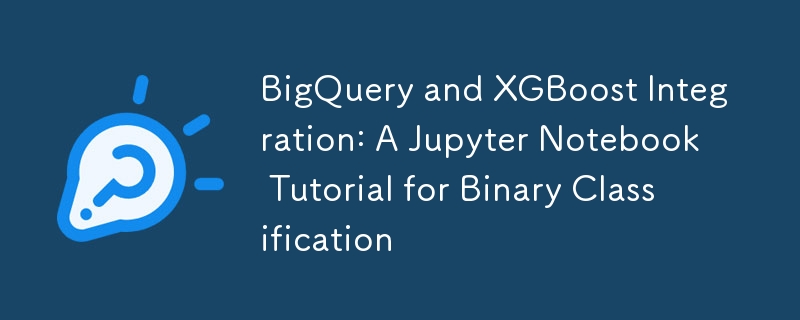BigQuery 和 XGBoost 整合:用於二元分類的 Jupyter Notebook 教學
Aug 12, 2024 pm 06:51 PM
介紹
在為表格資料選擇二元分類模型時,我決定快速嘗試一種快速的非深度學習模型:梯度提升決策樹(GBDT)。本文介紹了使用 BigQuery 作為資料來源並使用 XGBoost 演算法進行建模來建立 Jupyter Notebook 腳本的過程。
完整腳本
對於那些喜歡直接跳入腳本而不進行解釋的人,這裡是。請調整project_name、dataset_name和table_name以適合您的專案。
import xgboost as xgb
from sklearn.model_selection import train_test_split, GridSearchCV
from sklearn.metrics import precision_score, recall_score, f1_score, log_loss
from google.cloud import bigquery
# Function to load data from BigQuery
def load_data_from_bigquery(query):
client = bigquery.Client()
query_job = client.query(query)
df = query_job.to_dataframe()
return df
def compute_metrics(labels, predictions, prediction_probs):
precision = precision_score(labels, predictions, average='macro')
recall = recall_score(labels, predictions, average='macro')
f1 = f1_score(labels, predictions, average='macro')
loss = log_loss(labels, prediction_probs)
return {
'precision': precision,
'recall': recall,
'f1': f1,
'loss': loss
}
# Query in BigQuery
query = """
SELECT *
FROM `<project_name>.<dataset_name>.<table_name>`
"""
# Loading data
df = load_data_from_bigquery(query)
# Target data
y = df["reaction"]
# Input data
X = df.drop(columns=["reaction"], axis=1)
# Splitting data into training and validation sets
X_train, X_val, y_train, y_val = train_test_split(X, y, test_size=0.2, random_state=1)
# Training the XGBoost model
model = xgb.XGBClassifier(eval_metric='logloss')
# Setting the parameter grid
param_grid = {
'max_depth': [3, 4, 5],
'learning_rate': [0.01, 0.1, 0.2],
'n_estimators': [100, 200, 300],
'subsample': [0.8, 0.9, 1.0]
}
# Initializing GridSearchCV
grid_search = GridSearchCV(estimator=model, param_grid=param_grid, cv=3, scoring='accuracy', verbose=1, n_jobs=-1)
# Executing the grid search
grid_search.fit(X_train, y_train)
# Displaying the best parameters
print("Best parameters:", grid_search.best_params_)
# Model with the best parameters
best_model = grid_search.best_estimator_
# Predictions on validation data
val_predictions = best_model.predict(X_val)
val_prediction_probs = best_model.predict_proba(X_val)
# Predictions on training data
train_predictions = best_model.predict(X_train)
train_prediction_probs = best_model.predict_proba(X_train)
# Evaluating the model (validation data)
val_metrics = compute_metrics(y_val, val_predictions, val_prediction_probs)
print("Optimized Validation Metrics:", val_metrics)
# Evaluating the model (training data)
train_metrics = compute_metrics(y_train, train_predictions, train_prediction_probs)
print("Optimized Training Metrics:", train_metrics)
解釋
從 BigQuery 載入數據
之前,資料以 CSV 檔案的形式儲存在 Cloud Storage 中,但緩慢的資料載入降低了我們學習過程的效率,促使我們轉向 BigQuery 以實現更快的資料處理。
設定 BigQuery 用戶端
from google.cloud import bigquery client = bigquery.Client()
此程式碼使用 Google Cloud 憑證初始化 BigQuery 用戶端,該憑證可以透過環境變數或 Google Cloud SDK 設定。
查詢和載入數據
def load_data_from_bigquery(query):
query_job = client.query(query)
df = query_job.to_dataframe()
return df
此函數執行 SQL 查詢並將結果作為 Pandas 中的 DataFrame 傳回,從而實現高效的資料處理。
使用 XGBoost 訓練模型
XGBoost 是一種利用梯度提升的高效能機器學習演算法,廣泛用於分類和迴歸問題。
https://arxiv.org/pdf/1603.02754
模型初始化
import xgboost as xgb model = xgb.XGBClassifier(eval_metric='logloss')
這裡實例化了 XGBClassifier 類,使用對數損失作為評估指標。
資料分割
from sklearn.model_selection import train_test_split X_train, X_val, y_train, y_val = train_test_split(X, y, test_size=0.2, random_state=1)
該函數將資料拆分為訓練集和驗證集,這對於測試模型效能和避免過度擬合至關重要。
參數最佳化
from sklearn.model_selection import GridSearchCV
param_grid = {
'max_depth': [3, 4, 5],
'learning_rate': [0.01, 0.1, 0.2],
'n_estimators': [100, 200, 300],
'subsample': [0.8, 0.9, 1.0]
}
grid_search = GridSearchCV(estimator=model, param_grid=param_grid, cv=3, scoring='accuracy', verbose=1, n_jobs=-1)
grid_search.fit(X_train, y_train)
GridSearchCV 執行交叉驗證以找到模型的最佳參數組合。
模型評估
使用驗證資料集上的精確度、召回率、F1 分數和對數損失來評估模型的效能。
def compute_metrics(labels, predictions, prediction_probs):
from sklearn.metrics import precision_score, recall_score, f1_score, log_loss
return {
'precision': precision_score(labels, predictions, average='macro'),
'recall': recall_score(labels, predictions, average='macro'),
'f1': f1_score(labels, predictions, average='macro'),
'loss': log_loss(labels, prediction_probs)
}
val_metrics = compute_metrics(y_val, val_predictions, val_prediction_probs)
print("Optimized Validation Metrics:", val_metrics)
輸出結果
運行筆記本時,您將獲得以下輸出,顯示最佳參數和模型評估指標。
Best parameters: {'learning_rate': 0.2, 'max_depth': 5, 'n_estimators': 300, 'subsample': 0.9}
Optimized Validation Metrics: {'precision': 0.8919952583956949, 'recall': 0.753797304483842, 'f1': 0.8078981867164722, 'loss': 0.014006406471894417}
Optimized Training Metrics: {'precision': 0.8969556573175115, 'recall': 0.7681976753444204, 'f1': 0.8199353049298048, 'loss': 0.012475375680566196}
附加資訊
使用Google雲端儲存作為資料來源
在某些情況下,從 Google Cloud Storage 載入資料可能比從 BigQuery 載入資料更合適。以下函數從 Cloud Storage 讀取 CSV 檔案並將其作為 Pandas 中的 DataFrame 傳回,並且可以與 load_data_from_bigquery 函數互換使用。
from google.cloud import storage
def load_data_from_gcs(bucket_name, file_path):
client = storage.Client()
bucket = client.get_bucket(bucket_name)
blob = bucket.blob(file_path)
data = blob.download_as_text()
df = pd.read_csv(io.StringIO(data), encoding='utf-8')
return df
使用範例:
bucket_name = '<bucket-name>' file_path = '<file-path>' df = load_data_from_gcs(bucket_name, file_path)
使用 LightGBM 訓練模型
如果您想使用 LightGBM 而不是 XGBoost,只需在相同設定中將 XGBClassifier 替換為 LGBMClassifier。
import lightgbm as lgb model = lgb.LGBMClassifier()
結論
未來的文章將介紹如何使用 BigQuery ML (BQML) 進行訓練。
以上是BigQuery 和 XGBoost 整合:用於二元分類的 Jupyter Notebook 教學的詳細內容。更多資訊請關注PHP中文網其他相關文章!

熱門文章

熱門文章

熱門文章標籤

記事本++7.3.1
好用且免費的程式碼編輯器

SublimeText3漢化版
中文版,非常好用

禪工作室 13.0.1
強大的PHP整合開發環境

Dreamweaver CS6
視覺化網頁開發工具

SublimeText3 Mac版
神級程式碼編輯軟體(SublimeText3)
















